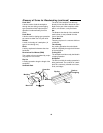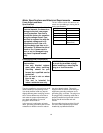
9
Additional Safety Instructions For:
Crosscut Type Cuts.
• Never use the rip fence when cross-
cutting.
• An auxiliary wood facing attached to
the miter gauge can help prevent
workpiece twisting and throwbacks.
Attach it to the slots provided. Make
the facing long enough and big
enough to support your work. Make
sure, however, it will not interfere
with the sawblade guard.
Before Starting
• Use jigs or fixtures to help hold any
piece too small to extend across the
full length of the miter gauge face
during the cut. This lets you properly
hold the miter gauge and workpiece
and helps keep your hands away
from the blade.
While Cutting
• To reduce the risk of blade contact,
always hold the miter gauge as
shown in “Basic Saw Operations -
Using The Miter Gauge”.
Glossary of Terms for Woodworking
Anti-Kickback Pawls
Device which, when properly maintained,
is designed to stop the workpiece from
being thrown towards the front of the saw
at the operator during ripping operation.
Arbor
The shaft on which a cutting tool is
mounted.
Bevel Cut
An angle cutting operation made through
the face of the workpiece.
Compound Cut
A simultaneous bevel and miter crosscut-
ting operation.
Crosscut
A cutting operation made across the width
of the workpiece.
Dado
A non thru cut which produces a square
sided notch or trough in the workpiece.
Featherboard
A device which can help guide work-
pieces during rip type operation.
Freehand
Performing a cut without the use of fence
(guide), miter gauge, fixture, hold down or
other proper device to prevent the work-
piece from twisting during the cutting
operation. Twisting of the workpiece can
cause it to be thrown.
Gum
A sticky, sap based residue from wood
products.
Heel
Misalignment of the sawblade such that
the blade is not parallel to the miter gauge
groove.
Kerf
The amount of material removed by the
blade in a through cut or the slot produced
by the blade in a nonthrough or partial cut.
Kickback
An uncontrolled grabbing and throwing of
the workpiece back toward the front of the
saw.
Leading End
The end of the workpiece which, during a
rip type operation, is pushed into the cut-
ting tool first.
Miter Cut
An angle cutting operation made across
the width of the workpiece.
Molding
A non through cut which produces a spe-
cial shape in the workpiece used for join-
ing or decoration.
Ploughing
Grooving with the grain the length of the
workpiece, using the fence. (A type of
non-through cut.)


















